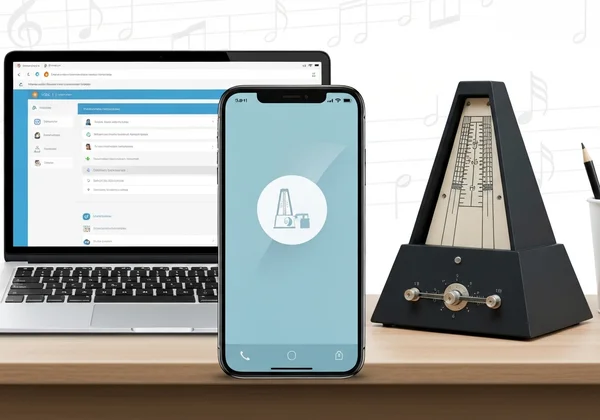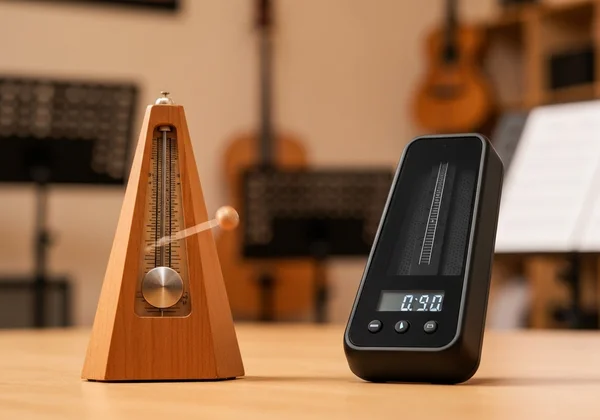Best Metronome: Online, App, or Physical? Your Buying Guide
Choosing the right metronome can feel overwhelming, with a sea of options from digital apps to classic physical devices. As a professional tool reviewer, I've spent countless hours testing different rhythm keepers to find what truly works. The quest for the best metronome depends entirely on your needs, but this guide is here to cut through the noise. How can a metronome improve my playing? By providing a steady, reliable pulse, it builds your internal clock, sharpens your timing, and unlocks your rhythmic potential.
This guide will break down the three main types of metronomes: online tools, mobile apps, and physical devices. We will explore the distinct advantages and disadvantages of each, helping you find the perfect rhythm companion for your practice sessions, performances, or even your fitness routine. Let's find your perfect rhythm and make an informed decision together.
Understanding Metronome Types: An Essential Overview
Before diving into a head-to-head comparison, it's crucial to understand the landscape. Each category offers a unique experience tailored to different users, from the serious musician to the casual hobbyist. Knowing the fundamental differences is the first step in your metronome buying guide.

The Power of Online Metronomes: Instant & Accessible Practice
An online metronome is a tool that runs directly in your web browser. There is no need for downloads, installations, or updates. These tools offer unmatched convenience, offering instant access to a steady beat from any device with an internet connection—be it a laptop, tablet, or smartphone.
The primary appeal is their accessibility and cost-effectiveness. Many, like our online metronome, are completely free and surprisingly powerful. They provide a full suite of features that once required expensive hardware, making them an excellent starting point for beginners and a reliable backup for professionals.
Exploring Mobile Metronome Apps: Rhythm in Your Pocket
Mobile metronome apps are dedicated applications you download from an app store onto your smartphone or tablet. Their main advantage is portability and the ability to function offline once installed. You can carry a powerful rhythm tool in your pocket wherever you go, which is ideal for lessons or jam sessions away from home.
But, convenience often comes with a few trade-offs. The market is saturated with apps, many of which are supported by intrusive ads or require subscriptions to unlock essential features. They also consume storage space and battery life on your device.
Physical Metronomes: Traditional Charm Meets Modern Precision
Physical metronomes are standalone hardware devices. They fall into two sub-categories: the classic, pyramid-shaped mechanical metronome with a swinging pendulum, and the modern, compact digital metronome. Mechanical versions offer a nostalgic, visual feedback that many musicians appreciate.
Digital hardware offers precision and advanced features, often including various sounds, rhythm patterns, and a headphone jack for private practice. Their main drawback is cost and portability. They are an additional piece of gear to purchase and carry, and they lack the instant accessibility of their software-based counterparts.
Online vs. App Metronome: Unpacking the Pros & Cons
For most users today, the choice boils down to using a browser-based tool or a dedicated app. While they seem similar, their user experiences can differ significantly. This is a critical comparison when considering an online metronome vs app.
Advantages of Using a Free Online Metronome
A top-tier free metronome offers the best of all worlds without the typical downsides. It combines the power of a professional tool with the convenience of the internet. Here’s why it stands out:
-
Zero Cost, Zero Ads: The most compelling advantage is that it's completely free without annoying pop-ups or banner ads interrupting your focus. This creates a superior, distraction-free practice environment.
-
No Installation Needed: Simply open your browser and start practicing. This saves precious storage space on your devices and eliminates any concerns about software compatibility or updates.
-
Professional-Grade Features: Modern online tools are no longer basic click tracks. A robust online metronome tool provides a vast BPM range (30-300), customizable time signatures (from 1 to 12 beats per measure), various beat subdivisions (triplets, sixteenth notes), and multiple sound options.
-
Advanced Functionality: Features like a
tap tempoallow you to quickly find the BPM of a song you're listening to, while an integratedBPM counterand practice timer help you structure your sessions effectively. This makes it an incredibly versatile rhythm practice tool. -
Universal Accessibility: It works seamlessly across all your devices—PC, Mac, Android, or iOS—as long as you have a browser. Your settings and preferred tempo are just a URL away.

Benefits and Drawbacks of Dedicated Metronome Apps
Metronome apps certainly have their place. Their primary benefit is offline functionality. If you frequently practice in locations without reliable internet, an app is a dependable choice. Portability is also a key selling point, as your phone is almost always with you.
However, the "freemium" model is prevalent. The free versions are often stripped of advanced features, forcing you into in-app purchases or subscriptions to access things like complex time signatures or subdivision options. Furthermore, persistent ads can be highly distracting, and some apps may raise privacy concerns by requesting unnecessary permissions.
Physical Metronome Review: When Analog or Digital Hardware Excels
While software has taken over, a physical metronome review shows that hardware still holds value for a specific audience. Let's look at why you might still consider a tangible device.
The Timeless Appeal of Mechanical Metronomes
The classic pendulum metronome, with its design famously patented by Johann Maelzel, is an iconic symbol of music practice. Its visual cue—the rhythmic swing of the arm—can be more intuitive for some learners than a flashing light. The organic, woody click is also aesthetically pleasing.
That said, they are bulky, fragile, and limited in functionality. They require a flat surface, must be wound up, and offer a limited set of standard tempos. They are more of a beautiful, functional piece of history than a versatile modern practice tool.
Digital Physical Metronomes: Advanced Features for Serious Musicians
Modern digital metronomes are compact, durable, and packed with features. High-end models from brands like Korg or Boss often include headphone outputs, volume control, and the ability to program complex rhythm patterns. For professional drummers or ensembles, these dedicated devices can be invaluable.
The biggest hurdle is cost, with advanced models costing a significant amount. They are also yet another item to remember to pack and keep charged. For most musicians, a high-quality online tool offers comparable features without the cost or hassle.

Choosing Your Perfect Rhythm Partner: Key Factors for Your Metronome
Ultimately, the metronome buying guide comes down to your personal needs. Consider these factors to make the right choice.
Matching Your Needs: From Beginner Rhythm Practice Tool to Advanced Player
- For the Casual Learner/Hobbyist: You need something simple, free, and instantly accessible. An online metronome is the perfect fit. It provides all the core functionality you need to build rhythm without any cost or complexity.
- For the Serious Musician: You require precision, customization, and advanced features like subdivisions and complex time signatures. While a high-end digital metronome is an option, a feature-rich online metronome provides professional-level control for free.
- For the Non-Musician (Dancer, Athlete): You need a simple way to set a specific tempo or find the beat of a song. The
tap tempofeature available on a quality online metronome is perfect for this.
Essential Features: Tap Tempo, BPM Counter, and Beyond
Regardless of which type you lean towards, ensure it has the core features you need. A wide, easily adjustable BPM range is essential. The ability to set different time signatures and use subdivisions is crucial for practicing anything beyond simple rhythms.
Features like a tap tempo and a visual beat indicator add significant value. The best solution is one that provides all these features in an intuitive, user-friendly interface. A powerful online metronome checks all these boxes, making it a superior choice for the vast majority of users.
Your Ideal Metronome Awaits: Start Practicing Smarter Today
After comparing online tools, mobile apps, and physical devices, a clear winner emerges for most people: the free online metronome. It removes the barriers of cost, installation, and advertisements while delivering a professional-grade feature set that rivals even expensive hardware. Its universal accessibility ensures you have a reliable rhythm partner whenever and wherever you need it.
Don't let timing be a barrier to your progress. The perfect tool is just a click away, ready to help you build a rock-solid sense of rhythm. Ready to elevate your practice? Start practicing smarter today with a powerful, free, and intuitive tool.
Frequently Asked Questions About Choosing & Using a Metronome
How can a metronome improve my playing and overall rhythm?
A metronome acts as an objective timekeeper, forcing you to play in perfect time. Regular practice with one develops your internal clock—a critical component of advanced musicianship—improves consistency, allows you to consciously increase speed accurately, and exposes rhythmic weaknesses in your playing that you can then correct.
What is a good tempo for practice when I'm just starting out?
When you are a beginner, the golden rule is to start slow. A tempo between 60 and 80 BPM (beats per minute) is ideal, a principle echoed by many music educators. The goal is not speed, but accuracy and evenness. Once you can play a passage perfectly at a slow tempo, you can gradually increase the speed.
How do I find the BPM of a song using a metronome or other tools?
The easiest way is to use a tool with a tap tempo feature. While listening to the song, simply tap a button in time with the beat for a few seconds. The tool will calculate and display the song's BPM. The online metronome tool has this feature built-in and ready to use.
How to use a metronome effectively for beginners?
To use a metronome effectively, start by setting it to a slow speed. Clap or tap along with the beat to internalize the pulse before you even pick up your instrument. Focus on aligning just one note perfectly with each click. As you get comfortable, you can begin playing simple scales or exercises, ensuring every note lands exactly on the beat.